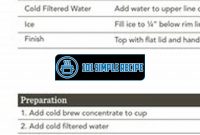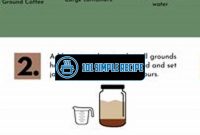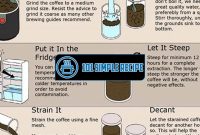If you’re a coffee lover, you’ve probably heard of the trendy and refreshing drink known as cold brew coffee. Making cold brew coffee at home may seem intimidating, but fear not – it’s actually a simple and satisfying process. Whether you’re looking to save money or customize your coffee to your liking, learning how to make cold brew at home will elevate your coffee game to new heights. This article will guide you through the steps, providing you with tips and tricks along the way. So put on your barista hat and get ready to embark on a journey to the perfect cup of cold brew coffee. ☕✨

The Origins of Cold Brew Coffee
Coffee has been enjoyed by civilizations for centuries, and its various preparations have evolved over time. One such preparation that has gained popularity in recent years is cold brew coffee. This unique method of brewing coffee offers a smooth and less acidic alternative to traditional hot brewing methods, making it a favorite among coffee enthusiasts worldwide.
Ancient Roots of Cold Brew
The origins of cold brew can be traced back to ancient times. In ancient China, cold-brewed tea was a common practice. The method involved steeping tea leaves in cold water for an extended period, resulting in a refreshing beverage with a different flavor profile compared to hot brewed tea. This notion of cold extraction slowly made its way to other countries and eventually led to the emergence of cold brew coffee.
Fun fact: The first recorded evidence of cold brew coffee dates back to the 1600s when Dutch traders developed a method of steeping coffee grounds in cold water for an extended period of time. This method was particularly popular among sailors who needed a quick and easy way to prepare coffee during long sea voyages.
Modern Revival of Cold Brew
While cold brew coffee may have originated centuries ago, it experienced a revival in the modern era. In recent years, coffee shops and specialty cafes have embraced the trend, offering cold brew as a regular menu item. This renewed interest in cold brew can be attributed to its unique flavor profile and the growing demand for alternative coffee preparations.
Did you know? Cold brew coffee is known for its rich, smooth taste and low acidity. The prolonged steeping process allows for a slower extraction of flavors compared to hot brewing methods, resulting in a coffee that is less bitter and easier on the stomach.
The Popularity of Cold Brew Today
In today’s coffee culture, cold brew has become increasingly popular among coffee enthusiasts. Its rise in popularity can be attributed to several factors. Firstly, the smooth and less acidic nature of cold brew appeals to individuals who find traditional hot brewed coffee too harsh on their stomachs. Additionally, cold brew coffee is often considered a refreshing and enjoyable alternative to a hot cup of joe, especially during the summer months.
Pro tip: Cold brew coffee is versatile and can be enjoyed on its own, over ice, or even mixed with milk for a creamy and indulgent treat.
Furthermore, the convenience of making cold brew coffee at home has contributed to its widespread popularity. With just a few simple steps and minimal equipment, anyone can enjoy a delicious cup of cold brew right in the comfort of their own kitchen.
In conclusion, the history of cold brew coffee dates back centuries, with its ancient roots in China and its modern revival in recent years. Today, cold brew has captured the hearts and taste buds of coffee lovers worldwide, offering a smooth and refreshing alternative to traditional hot brewed coffee. So why not give it a try and experience the unique flavors of cold brew for yourself?
The Science Behind Cold Brew Coffee
When it comes to making cold brew coffee at home, there is an interesting scientific process at play. Cold brew differs from traditional hot brewing methods in several ways, including the extraction process, chemical changes, and impact on flavor and acidity.
The Extraction Process
Let’s dive deeper into the extraction process of cold brew coffee. Unlike hot brewing methods, where hot water is used to extract flavor from the coffee grounds quickly, cold brew takes its time. The grounds are steeped in cold or room temperature water for an extended period, usually 12 to 24 hours.
This slow extraction process allows the coffee to release its flavors gradually, resulting in a smooth and less bitter taste. The extended steeping time allows for the extraction of different compounds compared to traditional brewing methods. As a result, cold brew often has a milder flavor profile.
Chemical Changes in Cold Brew
Now, let’s explore the chemical changes that occur during the cold brew process. One of the key components affected is the coffee’s acidity level. Hot water tends to extract more acidity from the coffee grounds, while cold water extracts less. This is why cold brew coffee is often less acidic and more gentle on the stomach.
Additionally, the prolonged steeping time in cold brew allows for the extraction of different chemical compounds. Some of these compounds, such as oils and fatty acids, are responsible for the unique flavors and aromas found in cold brew coffee. The absence of heat during the extraction process also prevents the breakdown of certain compounds, contributing to the distinct taste.
The Impact on Flavor and Acidity
The differences in the extraction process and chemical changes have a significant impact on the flavor and acidity of cold brew coffee. Due to the slower extraction, cold brew tends to have a smoother and less bitter taste compared to hot brewed coffee.
The lower acidity levels make cold brew more enjoyable for individuals with sensitive stomachs or acid reflux. It also allows for the natural flavors of the coffee beans to shine through, resulting in a more nuanced and balanced cup of coffee.
In summary, the science behind cold brew coffee involves a slower extraction process, different chemical changes, and a distinct impact on flavor and acidity. By understanding these scientific aspects, you can create your own delicious cold brew coffee at home.
Cookie in a Mug Recipe is a quick and easy dessert to enjoy with your homemade cold brew coffee.
Choosing the Right Coffee and Water
When it comes to making cold brew coffee at home, choosing the right coffee beans and water is crucial. The flavors and quality of your cold brew will greatly depend on these key factors. In this section, we will delve into the considerations you should keep in mind when selecting the perfect coffee beans and water for your cold brew.
Choosing the Right Coffee Beans
When selecting coffee beans for cold brew, it’s important to opt for a variety that is specifically suited for this brewing method. Look for beans that are labeled as “coarse grind” or “cold brew” to ensure optimal results. These beans are typically less acidic, resulting in a smoother and less bitter taste.
In addition to the grind, consider the origin and roast level of the beans. Experiment with different origins, such as Colombian, Ethiopian, or Brazilian, to find the flavor profile that suits your preferences. Light to medium roasts are commonly preferred for cold brew, as they bring out the unique characteristics of the beans without overpowering them.
Understanding the Role of Water
Water plays a crucial role in the extraction of flavors from coffee beans. For cold brew, you want to use filtered water to ensure a clean and pure taste. Tap water often contains impurities that can affect the final flavors of your brew.
It’s recommended to use a water-to-coffee ratio of 1:4. This means for every 1 ounce of coffee, you should use 4 ounces of water. This ratio can be adjusted based on personal preference, but it’s a good starting point for beginners.
Another important factor to consider is the temperature of the water. Cold brew requires a longer steeping time, usually overnight, which means the water will be in contact with the coffee grounds for an extended period. Using cold or room temperature water is key to achieving the desired extraction without any bitterness.
The Importance of Water Temperature
The temperature of the water used in cold brew significantly affects the flavor profile and extraction process. Unlike traditional hot coffee brewing methods, cold brew relies on a slow extraction process due to the lower water temperature.
Using boiling water for cold brew is not recommended as it can over-extract the coffee and result in a bitter taste. Instead, aim for a water temperature between 70°F (21°C) and 80°F (27°C). This range provides the optimal conditions for extracting the smooth, rich flavors of the coffee without any harsh or unpleasant characteristics.
Remember, the quality of your cold brew coffee is directly affected by the coffee beans and water you choose. Experiment with different beans, origins, grind sizes, and water temperatures to find the perfect combination that suits your taste preferences. Enjoy the journey of discovering the art of making delicious cold brew coffee at home!
Garlic Bread Stick Recipe is a delicious side dish that goes well with cold brew coffee.
The Art of Cold Brew Brewing
When it comes to making cold brew coffee at home, mastering the step-by-step process is essential. From grinding the beans to steeping and filtering, each stage plays a crucial role in achieving the perfect cup of cold brew. So, let’s dive into the details and explore the art of cold brew brewing!
The Proper Grinding Technique
The first step in creating a delightful cold brew is to ensure that your coffee beans are properly ground. The ideal consistency is coarse, similar to what you would use for a French press. This ensures that the water can extract the rich flavors without leaving behind any unwanted bitterness.
An important tip is to use a burr grinder, as it allows you to have better control over the grind size. Electric burr grinders are highly recommended as they provide consistent results. However, if you don’t have one, a regular blade grinder will suffice. Just make sure to pulse the beans a few times to prevent over-grinding.
Pro Tip: It’s crucial to grind your coffee beans just before brewing to preserve their freshness and aroma.
Steeping and Time Recommendations
Once you have your coarsely ground coffee, it’s time to start the steeping process. The ratio of coffee to water plays a crucial role in determining the strength and flavor of your cold brew. A general guideline is to use one part coffee to four parts water, but feel free to adjust according to your taste preferences.
Now, you can use a large jar or pitcher to combine the coffee and water. Stir gently to ensure all the coffee grounds are fully saturated. Then, cover the jar or pitcher and place it in the refrigerator for at least 12 to 24 hours. Cold brew requires a longer steeping time compared to hot brewing methods to extract those smooth, less acidic flavors.
Pro Tip: Experiment with different steeping times to find your perfect balance of flavors. You can try shorter or longer steeping times to obtain a lighter or stronger brew.
Effective Filtering Methods
After the steeping process is complete, it’s time to filter out the coffee grounds and extract the liquid gold. There are several effective filtering methods you can use:
- Using a French Press: This method involves slowly pressing down the plunger to separate the coffee grounds from the liquid.
- Using a Nut Milk Bag: Place the bag over a large jar or pitcher, then carefully pour the cold brew through it. Squeeze the bag gently to extract as much liquid as possible.
- Using a Paper Filter: Set up a funnel with a paper filter on top of a jar or pitcher. Pour the cold brew slowly, allowing the filter to catch the grounds as the liquid passes through.
Pro Tip: Whichever filtering method you choose, it’s a good practice to double-strain your cold brew to ensure a smooth and sediment-free result.
By mastering the art of cold brew brewing, you can enjoy a refreshing and flavorful cup of coffee right at home. So, grab your favorite beans, perfect your grinding technique, adjust the steeping time to your liking, and filter like a pro. Start your cold brew journey today and elevate your coffee experience!
Hoisin Sauce Recipe can be used to create a flavorful marinade for cold brew coffee-infused meat dishes.
Enhancing Your Cold Brew Experience
Flavoring Variations and Additions
When it comes to crafting the perfect cold brew coffee at home, exploring different flavoring variations and additions can help elevate your experience. By adding a burst of flavor, you can create a unique and personalized beverage that suits your taste preferences.
One popular way to enhance the flavor of your cold brew is by adding flavored syrups. Options such as vanilla, caramel, or hazelnut can add a sweet and aromatic touch to your coffee. Be sure to start with a small amount and adjust according to your taste.
Another way to switch up the flavor profile is by experimenting with different spices. Cinnamon, nutmeg, or even a pinch of cayenne pepper can add a subtle warmth and depth to your cold brew. Simply sprinkle them into the coffee grounds before brewing.
If you prefer a creamier and richer cold brew, consider adding a splash of dairy or non-dairy milk. Almond milk, oat milk, or coconut milk can add a smooth and creamy texture to your coffee. This can be particularly enjoyable when served over ice.
To take your cold brew to the next level, consider infusing it with natural flavors. You can achieve this by adding ingredients like citrus peels, vanilla beans, or even a hint of mint. Let these flavors steep in the coffee overnight for a refreshing and aromatic result.
Creative Cold Brew Cocktails
For those who enjoy a little indulgence in their coffee, experimenting with cold brew cocktails can bring a whole new dimension to your home brewing experience. The combination of coffee and alcohol can create unique and delicious flavor profiles.
One popular cold brew cocktail is the ever-classic Espresso Martini. Simply mix equal parts of cold brew coffee, vodka, and coffee liqueur. Shake it with ice and strain into a chilled glass. This cocktail is perfect for those who enjoy a strong and sophisticated beverage.
Looking for a refreshing cocktail option? Try a Cold Brew Mojito. Muddle fresh mint leaves, lime juice, and simple syrup in a glass. Add ice and pour in your cold brew. Top it off with a splash of soda water for an invigorating and minty twist.
If you prefer creamy and dessert-like cocktails, a Cold Brew White Russian might be just what you’re looking for. Mix equal parts of cold brew coffee, vodka, and coffee liqueur. Add a splash of cream or milk, and stir gently. The result is a decadent and indulgent treat.
Exploring Cold Brew Food Pairings
Pairing your cold brew coffee with suitable foods can further enhance your overall experience. The right combination can complement the flavors of both the coffee and the food, creating a harmonious and enjoyable taste sensation.
If you’re indulging in a sweet treat like a chocolate brownie or a slice of cake, consider pairing it with a bold and robust cold brew. The rich and bitter notes of the coffee can contrast beautifully with the sweetness of the dessert.
For a lighter snack option, try pairing your cold brew with a fresh fruit salad or a citrusy dish. The brightness and acidity of the fruits can help cleanse your palate between sips, leaving you refreshed and ready for the next delicious bite.
If you’re in the mood for something savory, a cold brew can be a great companion to foods like cheese or charcuterie. The complex flavors of the coffee can complement the salty and umami flavors of the cheese and cured meats, creating a delightful combination.
Don’t be afraid to get adventurous and try out different food pairings with your cold brew. The possibilities are endless, and you may discover surprising flavor combinations that will elevate your coffee experience.
Frequently Asked Questions
Here are some frequently asked questions about making cold brew coffee at home:
| No. | Questions | Answers |
|---|---|---|
| 1. | What is cold brew coffee? | Cold brew coffee is a coffee brewing method where coffee grounds are steeped in room temperature or cold water for an extended period of time, usually around 12-24 hours. The result is a smooth and rich coffee concentrate that is less acidic compared to traditional brewing methods. |
| 2. | What equipment do I need to make cold brew coffee at home? | To make cold brew coffee at home, you will need coarsely ground coffee beans, a jar or container for steeping, a filter or cheesecloth for straining, and optionally, a coffee grinder and a carafe for storing the coffee concentrate. |
| 3. | How long does it take to make cold brew coffee? | The steeping process for cold brew coffee takes around 12-24 hours, depending on your preference. It’s best to plan ahead and start the process the night before you want to enjoy your cold brew coffee. |
| 4. | Do I need to refrigerate cold brew coffee? | Yes, cold brew coffee needs to be refrigerated after it’s finished steeping. The coffee concentrate can be stored in the refrigerator for up to two weeks. |
| 5. | How do I dilute cold brew coffee? | To enjoy cold brew coffee, it’s usually diluted with water or milk. Start with a 1:1 ratio of concentrate to water or milk, and adjust according to your taste preferences. |
| 6. | Can I heat up cold brew coffee? | Yes, you can heat up cold brew coffee by adding hot water or milk to the coffee concentrate. However, note that heating it will change some of the flavor profiles, so it’s best enjoyed cold or over ice. |
Closing Thoughts
Thank you for reading our guide on how to make cold brew coffee at home! We hope you found these instructions helpful and that you’ll give cold brew coffee a try. It’s a refreshing and delicious way to enjoy your caffeine fix, especially during the hot summer months. Remember, the key to a great cold brew is patience and using quality coffee beans. So grab your supplies, start steeping, and get ready to experience the smooth and flavorful delight of homemade cold brew coffee. Stay caffeinated and visit us again for more delicious recipes and helpful brewing tips. Cheers!
Jump to Recipe
Cold Brew Coffee

Learn how to make cold brew coffee at home with this easy step-by-step guide. Cold brew coffee is a smooth and rich coffee concentrate that is perfect for hot summer days.
- 1 cup coarsely ground coffee beans
- 4 cups water
- Grind the coffee beans coarsely. You can use a coffee grinder or ask your local coffee shop to grind them for you.
- In a jar or container, combine the coarsely ground coffee and water. Stir gently to ensure all the coffee grounds are fully saturated.
- Cover the jar or container and let the coffee steep at room temperature for 12-24 hours. The longer it steeps, the stronger and more concentrated the coffee will be.
- After the steeping period, place a filter or cheesecloth over another jar or carafe. Slowly pour the coffee mixture through the filter, allowing it to strain out all the coffee grounds.
- To enjoy your cold brew coffee, dilute it with water or milk to your desired strength. Start with a 1:1 ratio of coffee concentrate to water/milk and adjust according to your taste. Serve over ice and enjoy!






